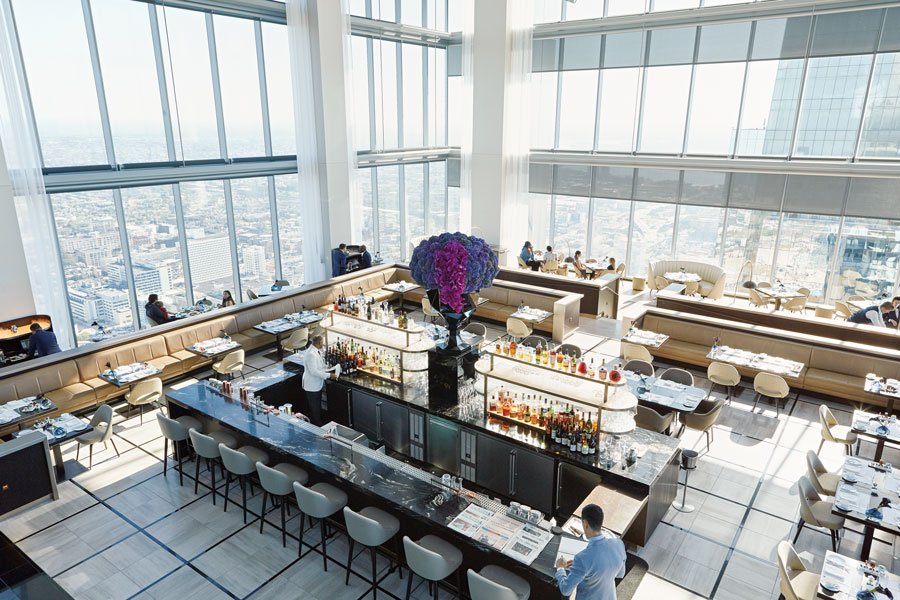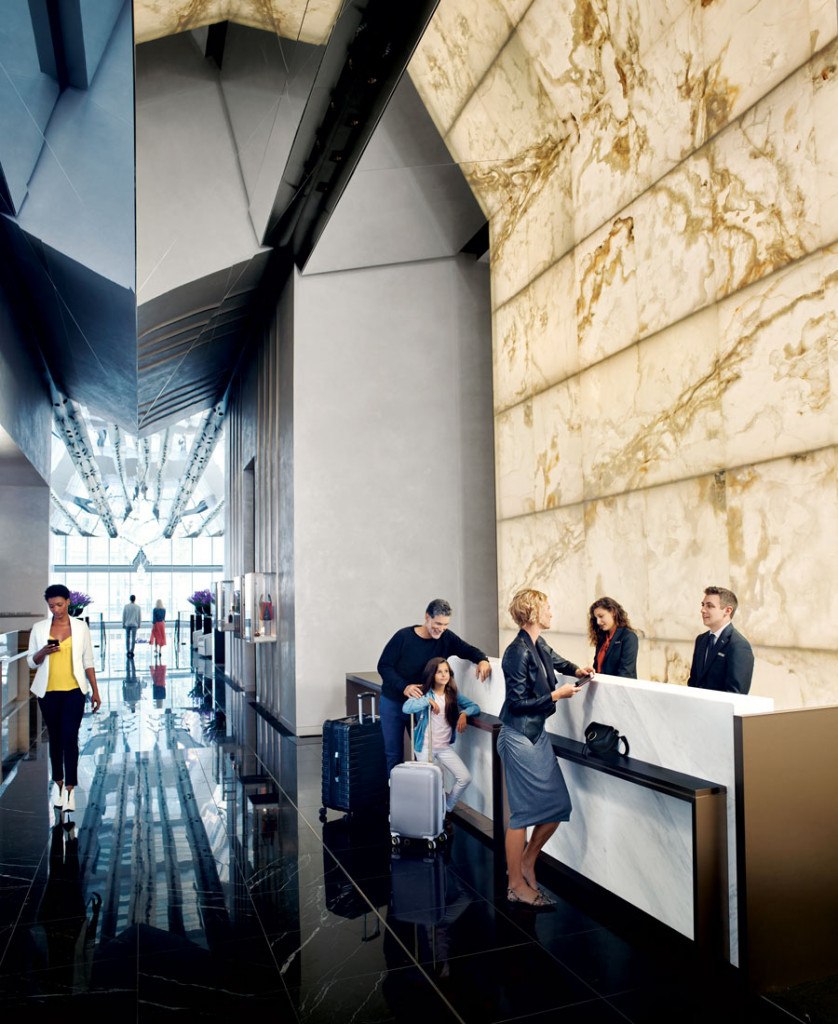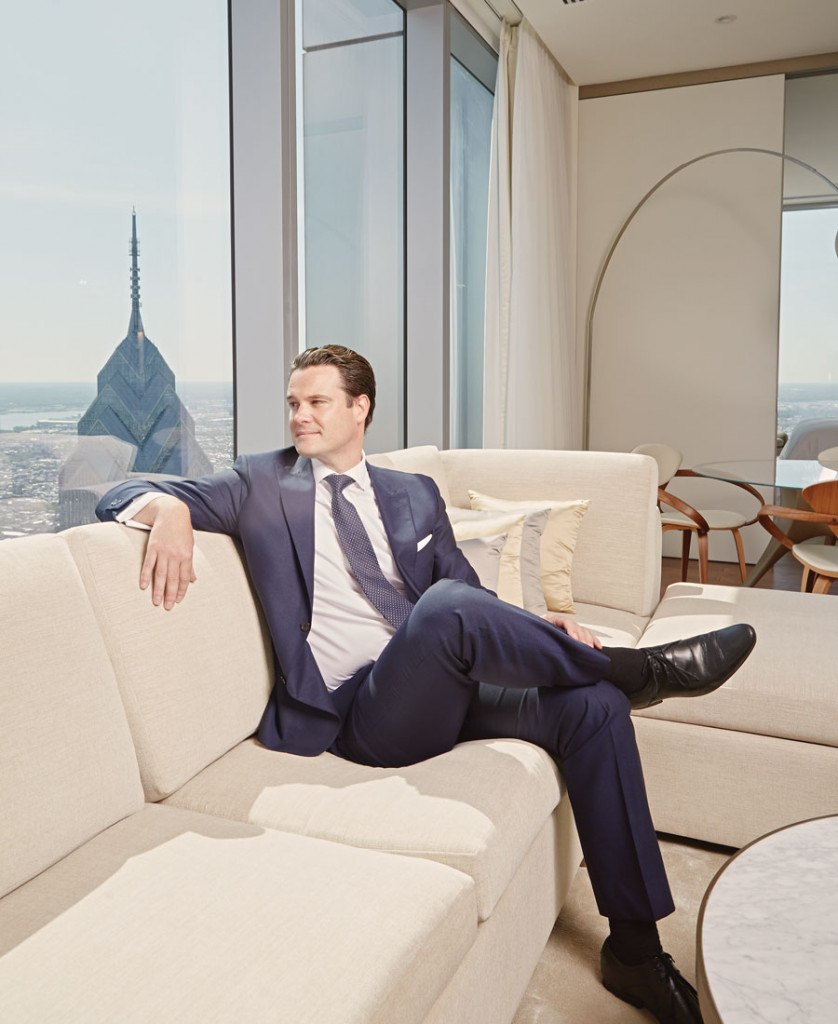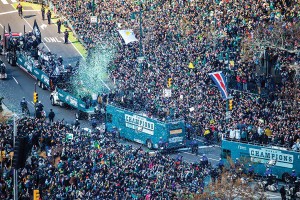Philadelphia Is Finally Becoming a Great Hotel Town
With a sparkling new Four Seasons atop Comcast’s second skyscraper, plus dozens more openings, renovations and innovations, Philly’s hotel scene is clearly on the rise.

Jean-Georges Philadelphia, the Four Seasons’ 59th-floor restaurant. Photograph by Emily Assiran
If I were Ben Shank, I’d be stressed. Can’t-sleep, pulling-out-my-hair-level stressed.
But Ben doesn’t seem stressed. Across the table from me, casually dressed in khakis and the kind of stylish short-sleeve button-down Wall Streeters wear on weekends in Bermuda, he’s sipping a cappuccino and running through his calendar.
Want to hear this story read aloud? Listen here.
After this, he’s heading to the spa to check out the steam rooms. After that, he’s taking the “house car” — a Tesla Model X, just delivered today — for a spin. Those aren’t exactly stressful-sounding activities, but here’s the thing: Ben Shank is not some finance bro on a Caribbean vacation. He’s the general manager of the new Four Seasons Hotel Philadelphia, and on this summer day, with one month to go before the grand opening of Philly’s most anticipated hotel of the decade, those steam rooms really need to be working.
It’s not that Philly’s old Four Seasons wasn’t important. As one of the Toronto-based company’s first U.S. hotels, it was crucial in introducing the brand now synonymous with luxury travel to the lucrative American market when it opened in 1983. It was also, for a certain Philadelphia crowd, a place to power-dine and rub shoulders with other fancy folks.
But this Four Seasons is different. First, there’s the location. Instead of out on the Parkway, the new property is in the center of the action. Or, rather, above the center of the action. Situated on floors 48 through 60 of the Comcast Technology Center, it’s the tallest hotel in not only Philly, but all of North America. Second, the restaurants. Greg Vernick has opened a seafood spot on the ground floor, 59 stories below a fine-dining juggernaut helmed by his former mentor, chef Jean-Georges Vongerichten. Third: the owner. Like most Marriott-brand and other chain hotels, Four Seasons properties aren’t actually owned by Four Seasons; the company operates them on behalf of developers. This particular hotel is a 20/80 joint venture between Liberty Property Trust and Comcast, whose CEO, Brian Roberts, has paid special attention to the project.
In case it isn’t clear, a lot of high-powered people are expecting this all to go right. As first in command, Ben is in charge of making that happen. This is also, I should mention, Ben’s first time, at 41, officially in charge of a hotel opening.
So yeah. Ben should be stressed. But if he’s worried, he’s doing a pretty good job of keeping those worries to himself. As we chat in Vernick Coffee Bar, the hotel’s swanky espresso shop, conversation is light and breezy when it turns to sleep-testing.
Before a Four Seasons room becomes available for reservations, it undergoes three rounds of sleep-testing to ensure it’s up to standards. For each sleep test, an employee stays overnight to work through a meticulous 106-point checklist. “Do the lights turn on? Do the shades close? When you turn the faucet, how long does it take to get hot water? You literally check everything from start to finish in the room,” Ben says of the process.
Sleep-testing seems like a cushy perk, but the fact that it’s taken so seriously is probably exactly why Ben seems so relaxed right now. He and his staff have done their due diligence, three times over. If something was going to go wrong, he’d know about it by now. Especially because he’s done multiple sleep tests himself, the most recent in a swanky corner suite with his wife, Jen, and their three kids.
Outfitted with a wraparound couch and a walk-in closet and shower, the room they stayed in runs almost $1,700 a night. During the test, guest services pitched a sleepover-ready tent in the living room and sent up mini-bathrobes for the kids. The next morning, the in-room dining team whipped up gluten-free, dairy-free pancakes for breakfast in bed. It was a true VIP experience, and, by his account, certainly not one that would have been part of Ben’s own upbringing.
Ben grew up in Wynnewood — his father taught at Temple, his mom was a nurse. A typical suburban teenager, he worked typical suburban teenage jobs — lifeguarding at the Radnor Hotel, front desk at the Wayne Hotel — through summers in high school at Lower Merion and later at Penn State. “Growing up, we did not stay at the Four Seasons,” he says. “That was not within our vocabulary.”
Ben was recruited to State College for varsity lacrosse but left the team to study abroad in Australia through a partnership with Cornell’s prestigious hotel school. While there, he met a fellow student who worked the door at Chicago’s Four Seasons. His friend spoke highly of the company, so Ben asked for help getting an interview at the sister property in Philly.
We all have to start somewhere, and Ben Shank started as a summer busboy in the hotel’s courtyard cafe. After graduation, he joined full-time as the cafe’s food and beverage manager and eventually worked his way up to maître d’ of the hotel’s Fountain restaurant, then a five-star, four-bell, $10-million-a-year operation.
“Ben was the type of manager you always wanted,” says David Jansen, the Fountain’s chef de cuisine at the time. “Someone that knew your name, that really listened. There’s a lot of egos in high-profile hotels, but he was calm, cool and collected no matter what happened.”
Ben’s next big promotion brought his family to New York, and for the next 11 years they crisscrossed the country while he climbed the corporate ladder at properties in San Diego, Maui, Scottsdale and, most recently, Orlando, where he helped open the sprawling, 26.5-acre Four Seasons resort at Disney. By the time he was tapped for the Philly job in 2016, his kids were five, seven, and eight, and his family was ready for a homecoming.
And for someone in the hospitality industry, it couldn’t have come at a better time.
In case you’ve somehow missed the construction, Philly is fully in the midst of a hotel boom. Between 2014 and 2016, three new hotels opened. Between 2017 and the time this year ends, we’re on track to have added 11 more (24 if you count Airbnb-style and extended-stay spots from the likes of Roost, AKA, Lyric and Sonder). And the building continues. A Live Casino & Hotel by the ballpark, the city’s first Hyatt Centric, and the massive, 755-room W/Element tower at 15th and Chestnut are all expected to follow in 2020.
Where hoteliers aren’t building, they’re upgrading — Old City’s Franklin Hotel became a Renaissance in mid-2018, while Braemer Hotels & Resorts transformed the Center City Courtyard by Marriott into the Notary Hotel, Philly’s first Autograph Collection hotel, in July. Where they aren’t upgrading, they’re renovating: the Sofitel, the Loews and the Westin are just a few of the properties undergoing multimillion-dollar face-lifts.
If you’re thinking this is all because everyone seems to be coming to Philadelphia right now, you’d be right. Per data from lodging analytics company STR, published by Visit Philadelphia, last year was a banner one for Philadelphia tourism. Center City saw its fifth record year in a row of hotel occupancy, topping out at 79.6 percent. Saturday-night occupancy, an industry benchmark for a city’s draw as a leisure destination, hit 91 percent — another all-time high. What’s most impressive, though, is that according to the Philadelphia Business Journal, Philly saw a bigger year-over-year rise in room occupancy than any other U.S. city; 45 million visitors poured into the area last year.
Saturday–night occupancy, an industry benchmark for a city’s draw as a leisure destination, hit 91 percent — an all–time high.
The big numbers translate into big business. Per Jeff Guarancino, president of Visit Philadelphia, Center City hotels did $675 million in revenue in 2018, a 9.2 percent leap from 2017. Revenue per available room, a key metric used by the hospitality industry to measure a market’s strength, increased five percent to $152.32, another all-time high for the city.
We didn’t get here overnight. In fact, we didn’t even get here over a decade.
To tell the story of the Philly hotel boom, you have to go back to 1997, Ed Rendell, and a podium. The city was inching its way out of financial catastrophe, unsure how to make up for a rapid loss of manufacturing jobs, when Rendell announced that the vacant PSFS skyscraper would be converted into a 590-room hotel. With this property and two others, Philly would finally hit 9,000 hotel rooms — the minimum required to draw a major political convention at the time.
Tourism was going to be a way out, a dream Rendell had outlined in an op-ed for the Inquirer the year before that announced $12 million to fund what would become Visit Philadelphia. And he had a plan: 2,000 more rooms by 2000. Rendell hit his mark, and the city went on to host its first big get: the 2000 Republican National Convention.
“I give Ed Rendell a lot of credit for creating the Avenue of the Arts and really making historic Philadelphia a better place,” says Ed Grose, executive director of the Greater Philadelphia Hotel Association. “Prior to that, I remember a lot of celebrities ate at the TGI Friday’s on the Parkway in the early ’90s, because the restaurant scene wasn’t what we have now.”
From there, you know the milestones: Made in America in 2012, Mass with the Pope in 2015, the DNC in 2016. All the while, we’ve kept traffic steady year-round with historical attractions, a buzzy dining scene, and a very concerted effort by Visit Philadelphia to bring people in. (Name a more iconic city marketing slogan than “With Love, Philadelphia XOXO” — I’ll wait.) Since 1997, Philly’s annual domestic visitation rate has risen 65 percent.
Hotel visitors — at least the ones to Center City last year — are a balanced mix: 34 percent were leisure travelers, 33 percent were group, 29 percent were business, and four percent were airline or government employees. As we headed down the Shore, tourists headed in — enough to keep occupancy rates hovering around 87 percent during a typically “dead” holiday like Memorial Day weekend. As Guarancino sees it, this is the exact kind of alchemy a developer looks for.
“Developers who invest millions of dollars are looking for a return on their investment,” he says. “They like to see consistency and predictability. This mix shows all business is strong, and that differentiates Philadelphia, because not every destination is that strong in the mix.”
And for a hometown guy like Brian Roberts, it’s business reason enough to build a hotel unlike any this city has ever seen.
Comcast’s 219-room Four Seasons Philadelphia is the cherry on top of the recent boom, and up here at the top, the air breathes differently. After a glass-walled elevator whisks you to the 60th-floor lobby, you’re greeted by a massive chrome sculpture overflowing with deep purple orchids and roses. The floral installation comes courtesy of Jeff Leatham, the floral-designer-to-the-stars with a client roster that includes several Kardashians. (Though based in L.A., Leatham keeps an office at 19th and Arch. For a mint, he’ll work on your wedding.)
Turn left at the marble reception desk and prepare to take in the grandeur of what, really, is the most important thing to know about this place. Most Western-style hotels situate the lobby on the ground floor and penthouses at the top, reserving the best views for those willing to pay a premium for them. (That’s capitalism for ya.) The Four Seasons Philadelphia flips the model Eastern-style, placing the lobby on the top. We’re always thinking about catching up to New York, but this inversion is something New York doesn’t even have — though global commercial capitals like Seoul, Tokyo and Shenzhen do.
Most Western-style hotels situate the lobby on the ground floor and penthouses at the top. The Four Seasons Philadelphia, on the other hand, flips the model Eastern-style, placing the lobby on the top.
The inversion also means that anyone willing to fork over $16 for a cucumber martini can take in the view. And what a view it is: JG SkyHigh, the 60th-floor lobby bar, and Jean-Georges Philadelphia, the connecting 59th-floor restaurant, both occupy the split-level atrium, which is surrounded on three sides by 40-foot floor-to-ceiling windows. From a window table at Jean-Georges, you’ll look directly down on City Hall and One Liberty Place. It’s both peaceful and awe-inspiring, but also a little strange. Existing up here above the potholes, the gridlock, the chaos … it feels like a Philly temporarily cleansed of its character. I wonder, the first time I visit for lunch, if the hotel needs something to anchor it back to the city below.

The lobby of the Four Seasons Philadelphia. Photograph by Jonathan Pushnik.
Speaking of lunch: Jean-Georges Vongerichten, the Jean-Georges behind the restaurant name, is a star chef with high-profile eateries in high-profile hotels across the world. Brian Roberts approached him personally for this project, and his fine-dining sensibilities blend with global flavors in an elevated but not unapproachable way. But the menu, like the view, doesn’t feel particularly connected to the city I’m dining above. That connection, I suspect, is instead meant to be found downstairs at Vernick Fish, where Greg Vernick is dishing out coastal fare inspired by the Jersey Shore.
Big names are also attached to the bones of the building. Sir Norman Foster, head of the London-based Foster + Partners, was the lead architect on the Comcast Technology Center and its Four Seasons hotel. The firm is responsible for, among dozens of world-renowned buildings, Apple’s Cupertino headquarters and the Hong Kong airport. The look of Vernick Fish was conceived by Adam Tihany, an O.G. of the hospitality-design world who’s created spaces for chef Daniel Boulud and worked on Thomas Keller’s famed Per Se. By stepping into Philly, these two have undoubtedly stepped up our global profile.
While it’s easy to feel good about the glitzy stuff, the new Four Seasons has also been a boon for what is already Philly’s second-fastest-growing job sector. Of its nearly 600 employees, only 47 are transfers. (They’ve come from as far as St. Petersburg and the Seychelles.) The rest are local hires. It’s a consciously diverse crew, and four of the eight executives on the hotel’s planning committee — the highest rung of leadership — are women. As is the case with most hospitality groups, promotion from within is prioritized, and a college degree isn’t necessarily required for advancement.
Point is: What’s good for tourists is good for Philadelphians, too. It is, if nothing else, something to keep in mind the next time you’re silently cursing convention traffic in Center City.
When I next see Ben, he’s swapped the Bermuda shirt for a crisp blue suit. It’s Monday, one week out from grand opening, and we’re in the basement of the tower for Morning Meeting. Every day at 9:30, including Saturday and Sunday, a key group of department heads gathers to review the day ahead. They go over wins (more than 100 reservations at each of the restaurants already) as well as areas for improvement (the spa needs more love on social media).
The most important item on today’s agenda: a visit from Four Seasons founder Isadore Sharp. That’s how big a deal this hotel is: The 87-year-old Canadian who first launched the brand is flying in to scope out the scene.
“Are you nervous?” I ask Ben when he shares the news.
“Heck yeah!” he says, but all I hear is excitement. Ben knows what a beauty this place is, and he’s ready to show it off.

Four Seasons GM Ben Shank. Photograph by Emily Assiran
Before that happens, though, there are final walk-throughs to be done. Ben, hotel manager Greg Viraud and I head to the 57th floor to inspect the rooms Sharp will be seeing. As we walk the hall, I can’t help but notice how wide and bright it is. Many hotels go big on common spaces and scrimp on sleeping quarters, but that’s not the case here. Doors are recessed a full 24 inches from the footpath, a luxury not even afforded on some of the toniest streets in Rittenhouse. That’s good, because with rates starting at $500 a night, these are some of the priciest rooms in the city.
Greg opens the door, and the work begins. They flick light switches and straighten coffee-table books.
“The music.” Ben notices almost immediately. “It’s too loud.”
Greg double-checks the TV, where the volume on the welcome display should be set to 10. Sure enough, it’s at 18.
Next, Ben opens the mini bar, where candy is laid out in glass jars with the Philly skyline on the lids. He turns an askew jar so that the skyline points straight up, to match the rest. Now, the room is perfect.
We head back to the lobby, where something (finally, sort of) goes wrong.
The staircase to Jean-Georges is flanked by two granite waterfall walls, and they’re not working right. Speaking in hushed tones, Ben steps away to field a call on the matter, while a group of engineers gathers to discuss the issue. It’s clear the team isn’t thrilled I’m witnessing this falter. Our PR escort tries to shift my attention, but I focus on the right-hand wall. I stare, hard, as water moves swiftly down the grooved surface. Everything seems … perfect. Yet again.
Ben will later tell me the grooves are too deep, which is causing the water to flick too far away from the walls, but if that’s the case, I certainly can’t tell. He’ll also tell me, in the same breath, the complex, multi-step plan his engineers have already sorted for a repair that won’t interfere with guests. Crisis, I am disappointed to report, averted. When Sharp arrives later this afternoon, the hotel will be in pristine — and, for Four Seasons, standard — working order.
That the “big” emergency I witness is such a small one is because the Four Seasons Philadelphia has been very important to a lot of very important people for a very long time. I know this because Brian Roberts tells me so, himself, over drinks with Christian Clerc, the Four Seasons’ president of worldwide hotel operations and boss of Ben’s boss, in a JG SkyHigh corner booth on opening night.
When I got the invite for this get-together three hours earlier, I was in D.C., visiting a friend’s newborn daughter. But if these guys weren’t missing opening night, then I sure as hell wasn’t, so I frantically packed my things and hopped the next train out. (Sorry, but not sorry, to the gentleman who watched me apply a full face of makeup in my seat.)
Brian isn’t exactly sure when he decided on a hotel in his second tower, but he is sure that once he decided, his top choice was a Four Seasons. Beyond luxe accommodations, Four Seasons hotels are known for their customer service — so much so that unlike most of its competitors, Four Seasons doesn’t offer a rewards program. Pretty much everyone, Comcast CEO included, has heard the jokes about Comcast customer service. Brian thought the partnership would be beneficial for his company, so he did what only billionaires can do: cold-called “Issy” Sharp. Brian and Sir Norman flew to Toronto to learn how to make what Brian wanted to be the best Four Seasons in the world. He envisioned a five-star, European-style experience, with Paris’s Four Seasons Hotel George V, a historic property often credited with setting the bar for luxury hotels worldwide, as his model. Unsurprisingly, Sharp stressed that their success wouldn’t be determined by the building, but by the service. Brian would need the right team.
When Ben was first recommended to lead the charge, Brian had concerns about his non-European background. But Christian’s team knew better.
“He’s the salt of the earth, but in a very sophisticated way,” Christian explains. The best hotels, after all, are internationally relevant but still provide a sense of place. Ben’s Philly upbringing would be that grounding force.
Brian agrees with the logic, both for the hire and the hotel itself. “We had to have a cheesesteak somewhere in the story,” he says.
I laugh, thinking back to two days earlier. On a tour of the in-room dining kitchen, Ben told me the team was struggling with a certain late-night Philly delicacy on the room-service menu. It was too fancy. Too froufrou. Then Steven Carter, a line cook from South Philly, griddled it up simple: “Meat. Bread. Grease.”
Finally, they had their sandwich. Ben whooped, hollered, and high-fived Steven as he told the story.
It’s here, in the only unrestrained moment I witness all week, that Brian gets his cheesesteak — and Philadelphia gets what it needs to bring our new sky-high wonder, the crown jewel of the hotel boom, back down to earth.
Published as “Hotels Rising” in the October 2019 issue of Philadelphia magazine.


